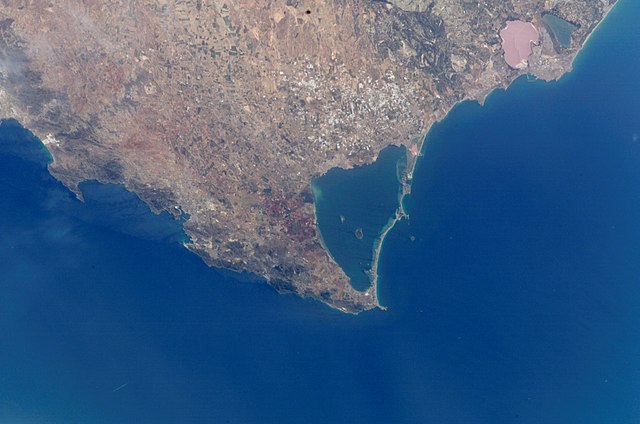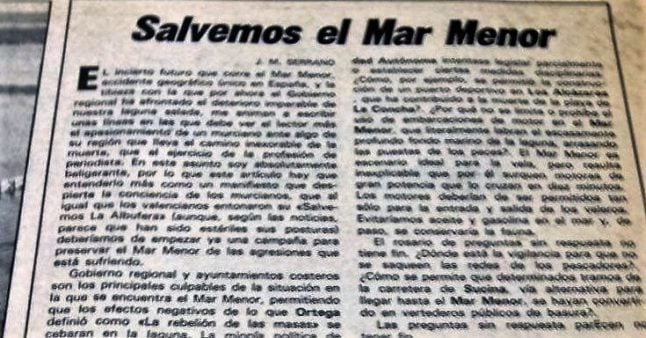Beneath the calm of one of Europe’s largest saltwater lagoons, whose coastline stretches some 70 kilometres (45 miles), a toxic storm has long been brewing, the product of years of nutrient pollution from intensive agriculture and rampant urban development.
The southeastern Spanish region of Murcia has extremely fertile land but the climate is dry with very little rainfall, meaning that for over a century locals have been looking to extract water from whatever source possible.
The advent of desalination and extraction machinery meant they turned to the Mar Menor (Smaller Sea), a coastal saltwater lagoon separated from the Mediterranean by a huge 22km sandbar.
For years, runoff water loaded with nitrates has entered the lagoon causing a vast bloom of algae which, as it died and began decomposing, decreased the amount of oxygen in the depths, creating a pocket of toxic anoxic — or oxygen-free — water that wiped out everything living there.
Experts say the fish died of suffocation, caused by a phenomenon known as eutrophication, an environmental hazard that causes aquatic ecosystems to collapse due to a lack of oxygen in the water.
Poor sewage systems in nearby towns – which have boomed in recent decades as tourism grows in the region – as well as discharge from mining activities have added to the problem.
 Photo of Mar Menor as seen from International Space Station. Source: Nasa
Photo of Mar Menor as seen from International Space Station. Source: Nasa
The latest environmental collapse is being blamed on the increase of water temperatues from 28.5 C to 31 C in just two days as a result of Spain’s latest heatwave, added to all the factors that have created a truly toxic environment for marine life.
The Mar Menor crisis is a multifaceted catastrophe of enormous environmental consequences which Spain has failed to solve for decades.
Here are five stats to understand the latest incident of countless dead fish washed up on Murcian shores in August 2021 and why this environmental tragedy just keeps happening.
1985
When exactly the destruction of Murcia’s Mar Menor began isn’t reported but 1985 was the first time the issue got some attention in the local press, when La Verdad journalist J.M.Serrano called out the “disproportionate growth of tourism” and the shortsightedness of coastal and regional authorities for not reacting to the “unstoppable deterioration of our saltwater lagoon”.
Since 1987, no plans have been made to reduce water extractions as mandated by Spain’s 1985 Water Law, which theoretically protected groundwater and classified it as public property.

1985 article on the destruction of Murcia’s Mar Menor in local daily La Verdad.
Three decades on and the situation has only worsened.
In 2016, the Mar Menor started to be described as a “green soup” by environmentalists (due to its high temperature and the abundance of phytoplankton triggered by excessive nutrients).
Images of mountains of dead fish piled up on the shores have been common almost every year ever since, and the latest evidence of this in August 2021 is the worst on record.
4.5 tonnes
That’s how many tonnes of dead fish have been cleared in the past week since the inhabitants of Murcia started noticing what was occurring. This represents 1.5 tonnes more than in 2019, which was the worst example of destruction in the Mar Menor up until then.
Almost all the species being washed up lived around the sea bed, including fish species such as gobies or big-scale sand smelt, shrimp, crabs, eels and more.
By 2015, 85 percent of the Mar Menor’s seagrass had been killed.
8 closed beaches
This year, authorities in the Murcian city of Cartagena have had to close eight beaches as the amount of rotting fish built up on the shores of the southeastern region became a health hazard for locals and holidaymakers.
Although these may just be temporary closures, images of the environmental catastrophe have been covered by the BBC, The Guardian and other international media, with Murcia hoteliers and real estate companies expressing concern over the negative impact it could have on the region’s international reputation.
President of local hotel association Hostecar Juan José López told local daily La Opinión de Murcia there was a “considerable” drop in tourism income and holiday bookings following the 2019 environmental crisis.
“Then came the pandemic, which did not help and now this. It’s disheartening,” López said about the impact this latest catastrophe can have in a region where 10 percent of the population works in the tourism industry.
In 2017, all beaches in the Mar Menor were stripped of their blue flag status.
8,000 ilegal hectares
Who is accountable for this increasingly dire situation is now the centre of political wrangling between Murcian authorities and Spain’s national government.
According to Spanish government spokesperson Isabel Rodríguez, there are around 8,000 hectares of land being used for agricultural purposes near the Mar Menor area which have not been awarded concessions to use water.
But agricultural companies have been able to install hundreds of desalination machines nonetheless in order to make the Mar Menor’s brackish groundwater of aquifers suitable for irrigation.
For Murcian authorities, it’s Madrid’s turn to intervene, whereas Pedro Sánchez’s government accuses Murcia’s regional government of allowing these practices to proliferate illegally for years, despite knowing that the outflow of brine and nitrates end up in the Mar Menor.
Ecological disasters continue to rage in Spain. Images were taken this week in Mar Menor, Murcia, Europe’s largest saltwater lake. Scientists are divided between weather it’s direct climate change (excessive heat causing deoxygenation) or nitrate-laden runoffs from agriculture. pic.twitter.com/rAT2i9wUeC
— Sam (@SamTwits) August 24, 2021
300,000 tonnes of nitrates
The impact this immense underground network of illegal installations has had on the Mar Menor is hard to put into numbers, at least in terms of the number of flora and fauna species that have perished.
Spain’s Environment Ministry estimates 4,000 kg of nitrates end up in the Campo de Cartagena aquifer on a daily basis, which in 2018 amounted to 300,000 tonnes of nitrates derived from intensive agriculture.
One of the solutions being suggested to solve the catastrophe is to empty this gargantuan amount of pollutants from the aquifer, but environmentalists are divided over whether it will cause more harm than good.
We are experiencing these days a massive fish mortality at #MarMenor a unique coastal lagoon in SE Spain caused by the nutrients coming in effluents from intensive agriculture in surrounding areas. To learn + about the causes behind this ecological disaster see👇 #SOSMarMenor https://t.co/1zYMOraxU3
— Fernando T. Maestre (@ftmaestre) August 23, 2021
The Campo de Cartagena is a plain of about 1,600 sqm whose waters flow into Murcia’s Mar Menor.
Agricultural groups have rejected accusations from authorities, arguing they aren’t to blame for the Mar Menor crisis and that they’re fully compliant with local legislation, as not having a registered licence does not really prevent them from extracting water.
500,000 signatures
In order for the Spanish Parliament to consider a draft law spearheaded by citizens, half a million people must put their name down to express support for the Mar Menor crisis for it to go up for debate.
As of August 2nd 2021, they had collected 224,000 in-person signatures, meaning they require a further 276,000 more signatures by October 28th, something which is proving particularly challenging during the pandemic as digital signatures do not count in this case.
If they reached the 500,000-signature mark, it would allow the rights of the Mar Menor to be defended in court as if it were a legal person or business.
Spokesperson for the Mar Menor Scientific Committee Ángel Pérez Ruzafa has said environmental catastrophes such as the one seen in recent days “will happen again two, three, four times, with even greater severity” as long as the entry of nutrients into the ecosystem persists.
His organisation has listed 100 ideas where everyone from neighbours to trade unions and town hall authorities can help save the Mar Menor.



 Please whitelist us to continue reading.
Please whitelist us to continue reading.
Member comments